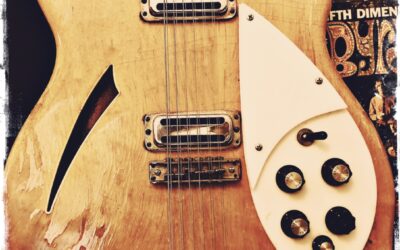There are few acoustic guitars that are as recognizable and influential in the world of music as Gibson’s J-45 model. It is regarded as Gibson’s most famous and widely used acoustic guitar, and countless guitarists throughout the second half of the 20th century relied on a J-45 or J-45 variant in the studio, the writing room, or the stage.
In general terms, the J-45 is a slope shouldered dreadnought with a spruce top, mahogany back and sides, a mahogany neck and rosewood fingerboard, and a 24.75” scale length.
The roots of the J-45 go back to 1934, when Gibson introduced the Jumbo. Before the Jumbo was produced, the largest flat-top that Gibson manufactured was the Nick Lucas model, which was a fairly narrow guitar with a deep body. The Nick Lucas was popular for a time, but in 1932 Martin introduced the Dreadnought, a large body guitar that was much louder and deeper sounding than anything in the Gibson catalog.
It became known for its volume and projection, and quickly became a much-desired guitar.
Gibson describes the Jumbo in their 1934 catalog as producing “a heavy, booming tone so popular with many players who do vocal or small combination accompaniment for both personal and radio appearances. The bass of this model will amaze you, and of course the clear, brilliant treble is in perfect balance.”
Although the Jumbo was sought after, a price of $60 was too expensive for many musicians in Depression-era America. Gibson stopped production due to lack of sales in early 1936.
Gibson introduced two new models in 1936 — the Advanced Jumbo, which was a more highly appointed guitar with rosewood back and sides designed to compete with Martin’s D-28; and the J-35, which was essentially a less expensive version of the original Jumbo, and was intended to compete with Martin’s D-18. The J-35 sold for $35 and was produced from 1936 into mid-1942.
To reduce the price from the Jumbo, Gibson removed the neck binding, replaced the inlaid logo with a silkscreen, switched to less expensive tuners, produced most J-35’s without scalloped braces, and switched the neck, back, and sides to a dark red mahogany from a more labor intensive sunburst finish.
It became a fairly common guitar of the era; Doc Watson was known for using a J-35 in the early part of his career.
In 1942, World War II was straining the manufacturing resources and supply lines of American companies, and Gibson simplified their production line of guitars to reflect these issues. It was during this period that the J-45 was introduced. Differences between the J-45 and 35 were minor; the 45 now featured a teardrop shaped pickguard, the peghead was radiused as opposed to straight sided like the 35, the Gibson logo was changed and silkscreened in a gold color, and the “banner” logo with “Only a Gibson is Good Enough” was added. The neck shape changed from a V to a rounder “baseball bat” shape.
For the rest of the war, the guitars reflected the material shortages that Gibson was faced with. Some guitars were made with maple necks, tops were often not book matched, and there are some J-45s from this era with 4- piece tops instead of 2-piece tops. Truss rods were also not included in these guitars due to a shortage of metal. These necessary changes aside, guitars from this era are known for their incredible tone.
The J-45 remained mostly the same in specification until the early 1950s. The rectangle bridge was replaced with a top-belly design, which offered some resistance to the top’s tendency to start to bulge up, but did not affect the top’s vibration behind the bridge, which is essential to an acoustic guitar’s tone and volume. A 20th fret was added in 1955. In 1956, Gibson began offering their J-45 with an adjustable bridge saddle which was popular with customers, but also known to have a negative impact on tone and volume. In general, 1960s J-45s are very highly regarded and known to be well-built, great sounding instruments.
In 1962, Gibson replaced the traditional brown sunburst with a cherry sunburst, and in 1968, changed over to a square shouldered body style, to simplify production. Gibson could use a single mold for all of their flat top guitars except the J-200. This was the “Norlin era” of the company, and guitars from this period are known to have a marked decrease in quality, appearance and tone. Sales of the J-45 dropped considerably by the late 1970s, and the model was dropped entirely in 1982. Gibson did not resume making J-45 until 1984, bringing back the round shoulders and more traditional aesthetic elements.
Over the years, Gibson has done countless variants of the J-45 with different woods various levels of appointments, and artist signature models, but the tried and true formula of mahogany, a sunburst finished spruce top, round shoulders and short scale length has stood the test of time. Gibson’s current production model is not all that far removed from the models of the 1950s, with some modern upgrades.
The J-45 has become an iconic guitar, and has been used by a tremendous list of musicians over the decades. Some artists known for their use of a J-45 or a variant thereof include Bob Dylan, Buddy Holly, Elvis Presley, Woody Guthrie, Donovan, Bruce Springsteen, Woody Guthrie, James Taylor, John Hiatt, Lightnin’ Hopkins, Gillian Welch, and the list goes on.
As long as music continues to be made, the J-45 will certainly still play a role.
Depth of Sides:
1934 Jumbo 4.44
1937 J-35 4.31
1943 J-45 4.34
1958 J-45 4.39




0 Comments